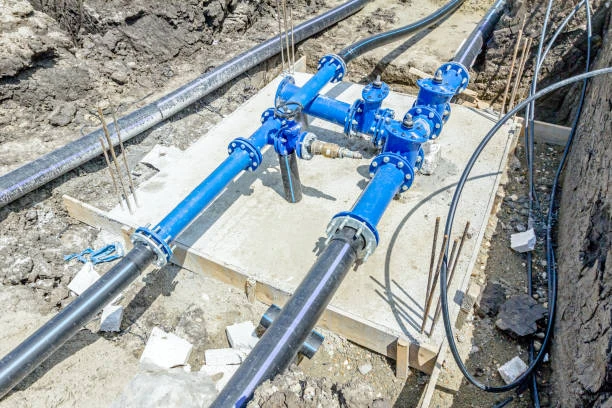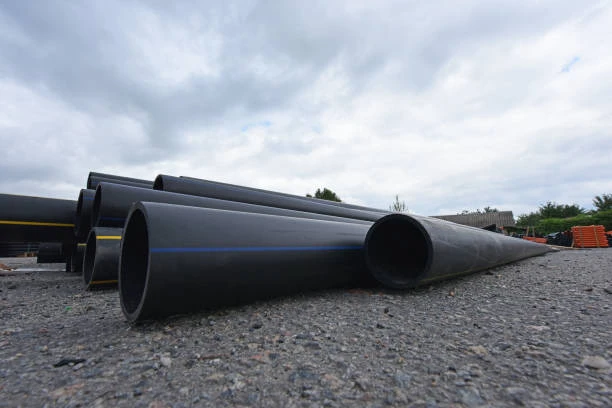High-Density Polyethylene HDPE pipe are increasingly becoming the material of choice in wastewater treatment plant projects due to their exceptional durability, resistance to corrosion, and ease of installation. As municipalities and industries seek to upgrade their wastewater management systems, HDPE pipes offer a reliable solution. Integral to the effectiveness of these systems are pipe press fittings, which enhance the performance and longevity of HDPE piping. This article explores the advantages of HDPE pipe in wastewater treatment plants and highlights the critical role of pipe press fittings in these projects.

Understanding HDPE Pipe
What is HDPE?
High-Density Polyethylene (HDPE) is a thermoplastic polymer recognized for its high strength-to-density ratio. This versatile material is widely used in various applications, particularly in the construction of pipes for water supply and wastewater management.
Key Features of HDPE Pipe
- Durability: HDPE pipes are highly resistant to corrosion, chemicals, and environmental stressors, ensuring a long lifespan in harsh conditions.
- Flexibility: Their flexibility allows for easy installation, especially in uneven terrains, without the risk of cracking.
- Low Maintenance: With a smooth interior surface, HDPE pipes require minimal maintenance, leading to cost savings over time.
- Environmental Benefits: HDPE is recyclable and can be made from post-consumer materials, supporting sustainable practices in construction.
The Importance of Wastewater Treatment Plants
Wastewater treatment plants play a crucial role in managing and treating wastewater from residential, commercial, and industrial sources. They help protect public health and the environment by:
- Removing Contaminants: Treatment processes effectively remove pollutants from wastewater, making it safe for discharge or reuse.
- Protecting Water Sources: Proper treatment prevents contamination of rivers, lakes, and groundwater, safeguarding ecosystems.
- Promoting Public Health: Effective wastewater management reduces the risk of waterborne diseases, promoting overall community health.
Advantages of HDPE Pipe in Wastewater Treatment Plants
HDPE pipes offer several benefits that make them ideal for wastewater treatment plant projects:
1. Resistance to Corrosion
Wastewater can contain corrosive substances that degrade traditional materials like metal and concrete. HDPE pipes resist corrosion, ensuring their longevity and reducing the need for frequent replacements.
2. Chemical Resistance
The chemical composition of wastewater can vary significantly. HDPE pipes are resistant to a wide range of chemicals, making them suitable for transporting wastewater without risk of degradation.
3. Lightweight and Easy to Handle
HDPE pipes are much lighter than traditional materials, simplifying transportation and installation. This is particularly advantageous in wastewater treatment projects, where large diameters are often required.
4. High Flow Capacity
The smooth internal surface of HDPE pipes minimizes friction loss, allowing for higher flow rates. This is crucial in wastewater treatment, where efficient movement of liquids is necessary.
5. Flexibility in Installation
HDPE pipes can be easily bent and maneuvered around obstacles, allowing for more straightforward installations. This flexibility is beneficial in tight spaces and uneven terrains common in wastewater treatment facilities.
The Role of HDPE pipe Press Fittings
Pipe press fittings are critical components that enhance the functionality of HDPE piping systems in wastewater treatment plants. Their advantages include:
1. Quick Installation
One of the most significant benefits of pipe press fittings is the speed of installation. The pressing technique eliminates the need for welding, adhesives, or extensive labor, allowing for faster project completion.
2. Reliable Connections
Pipe press fittings create secure connections that minimize the risk of leaks. This is particularly important in wastewater applications, where leaks can lead to contamination and environmental issues.
3. Reduced Labor Costs
The simplicity of using pipe press fittings reduces labor costs associated with installation. Fewer steps in the installation process mean less time and fewer workers are needed on-site.
4. Compatibility with HDPE Pipe
Designed to work seamlessly with HDPE piping systems, pipe press fittings ensure that connections are robust and effective, enhancing the overall reliability of the wastewater treatment system.
Installation Best Practices for HDPE Pipe and Pipe Press Fittings
To maximize the efficiency of HDPE pipes and pipe press fittings in wastewater treatment plants, following best practices during installation is essential:
1. Site Preparation
Before installation, ensure the site is properly prepared. This includes clearing debris and ensuring that the ground is stable and suitable for pipe placement.
2. Quality Control
Inspect all HDPE pipes and fittings before installation to check for defects. Any damaged materials should be replaced to ensure system integrity.
3. Use the Right Tools
Employ specialized tools for pressing fittings that are compatible with HDPE pipes. Using the correct tools will help achieve optimal performance and secure connections.
4. Follow Manufacturer Guidelines
Always adhere to the manufacturer’s installation instructions for both HDPE pipes and pipe press fittings. This ensures compliance with safety and performance standards.
5. Conduct Regular Inspections
After installation, conduct routine inspections to monitor the system for leaks, wear, or potential issues. Early detection of problems can prevent costly repairs and downtime.
Environmental Considerations
Using HDPE pipes in wastewater treatment plants aligns with environmental goals by promoting sustainability. These pipes are recyclable and contribute to reducing the carbon footprint associated with traditional materials. By choosing HDPE, municipalities can enhance their green initiatives while ensuring effective wastewater management.
Future Trends in Wastewater Management
As technology advances, the future of wastewater treatment will likely involve more innovative uses of HDPE piping and pipe press fittings. Smart water management systems, integrated with sensors and data analytics, may optimize wastewater treatment processes and improve efficiency. These advancements will further solidify HDPE’s role in sustainable wastewater management.
Conclusion
HDPE pipes offer a multitude of advantages for wastewater treatment plant projects, from durability and chemical resistance to flexibility and ease of installation. Pipe press fittings play an essential role in enhancing the effectiveness of these systems, ensuring secure connections and reducing installation time. As the demand for sustainable and efficient wastewater management solutions continues to grow, the integration of HDPE piping and pipe press fittings will remain at the forefront of industry advancements.
FAQs
- What are the benefits of using HDPE pipes in wastewater treatment? HDPE pipes are durable, corrosion-resistant, lightweight, and chemically stable, making them ideal for transporting wastewater.
- How do pipe press fittings work? Pipe press fittings create secure connections by compressing the fittings onto the pipes using specialized pressing tools, eliminating the need for welding.
- What is the importance of a wastewater treatment plant? Wastewater treatment plants remove contaminants from wastewater, protecting public health and the environment while ensuring safe water discharge.
- How can I ensure proper installation of HDPE pipes? Follow manufacturer guidelines, use appropriate tools, conduct site preparations, and inspect materials before installation.
- Are HDPE pipes environmentally friendly? Yes, HDPE pipes are recyclable and can be produced from post-consumer materials, supporting sustainability in wastewater management.


















